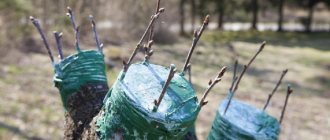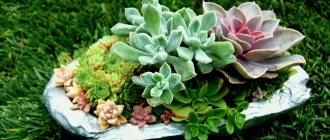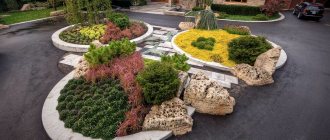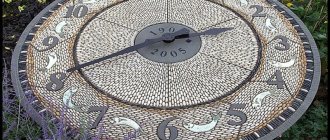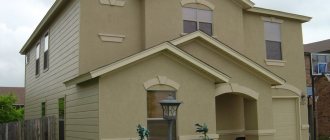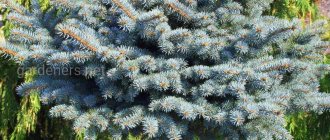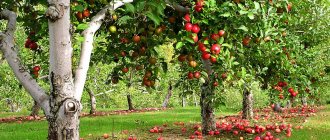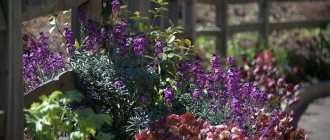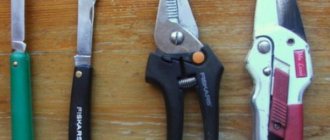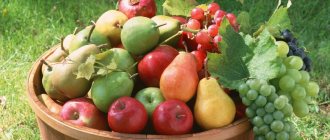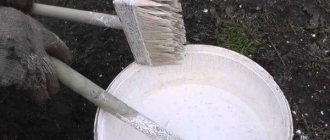What types of dwarf trees are there?
The dwarf apple tree is especially popular among gardeners. As a result of breeding work, many varieties of low-growing apple trees were developed. All of them produce high yields and are distinguished by enviable resistance to diseases. In addition, the apple tree is practically the only tree species for which you can easily make a dwarf rootstock.
Dwarf apple tree in the garden
Dwarf pears are hardy fruit trees. They are not afraid of weather anomalies. Pears are famous for their resistance to disease and bear fruit well.
The dwarf Sweet Cup peach reaches a height of no more than 1.8 m. The fruits have white flesh and are pleasant to the taste. Resistant variety. It is not afraid of severe frosts, and it will not suffer from drought. Gives a stable and high yield.
The UFO peach is resistant to many diseases, drought and low temperatures. A very productive and hardy variety. The pulp of the fruits is yellow in color, they taste sweet with a barely noticeable sourness.
The dwarf plum "Blue Free" is frost-resistant, so the variety is suitable for growing in areas with cold climates. Resistant to diseases such as root canker and chlorosis. The oval, sweet-sour fruits are colored in an intense dark purple color, which is even closer to black, and have a waxy coating.
Plum "Chachakskaya" is characterized by late fruit ripening. It will be possible to enjoy plums only at the end of September. The variety is resistant to diseases and changing weather conditions.
The President plum tolerates even the harshest winters well. Sweet fruits with yellowish-green flesh are characterized by excellent quality, not sour. The variety is an unpretentious plant, so it is very easy to care for.
Expert opinion
Yulia Yurievna
I have a large garden and vegetable garden, several greenhouses. I love modern methods of cultivating plants and mulching the soil, and I share my experience.
Ask a Question
Among the dwarf fruit trees that can be placed in the garden, apricots are also worth mentioning. For example, the very early variety Airlie Red Orange has large light orange fruits. They taste sweet, and may appear red in the sun. The harvest is well transported and can be used not only for personal consumption, but also for sale. Among this variety of plants there are also late apricots. For example, the Hardy variety. It is considered quite common. It tolerates frosty winters well and lack of watering in the hot season. Apricots are very sweet, the pulp is easily separated from the pit. The color is deep orange. Crimean Amur apricots are classified as mid-late varieties. It is distinguished by large fruits, some of them reach 90-100 grams. Sweet, but have a slight sourness. The variety is also distinguished by a strong pleasant aroma.
Criterias of choice
How rich the harvest will be depends on the correct choice of low-growing seedling. A dwarf crop is distinguished from a regular fruit tree by its large buds and fibrous root system. To grow a garden of dwarf species, you need to buy one-year-old or two-year-old scions. Gardeners recommend taking a regional scion .
When choosing a place to plant a dwarf breed, experts recommend getting to know your neighbors. The presence of maple, oak or linden will have a positive effect on the further growth and development of fertile species. But it is better to exclude the presence of alder, sedge or horsetail in adjacent areas, since these crops grow in soil with high acidity, which is absolutely unsuitable for fruit species.
Pros of growing dwarf crops
Low-growing varieties are distinguished by the uniformity of their crown. Low-growing trees are easier to harvest. Fruit tree seedlings are characterized by high survival rate and friendly growth.
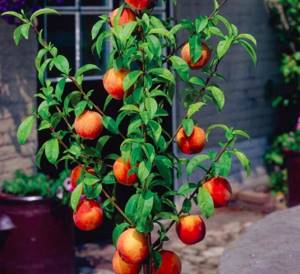
Dwarf peach
Unlike standard plants, dwarf plants have a compact shape and do not require constant pruning.
It takes a little time to form the crown and spray the dwarf garden against pests. They make harvesting easier and the percentage of “broken” fruits is reduced.
They are distinguished by early fruiting and rapid harvest ripening.
The fruits of the described plants contain a higher percentage of useful substances than standard varieties. The fruits have the best appearance, they are always large. The trees bear fruit annually.
Harvesting
It has been noted that when growing fruit trees, people get maximum pleasure from harvesting. Due to the size of the trees, harvesting is easy and quick . Gardeners spend a lot of time and effort on growing a dwarf garden, but the amount of early fruits collected is worth it. Experts are of the opinion that it is imperative to whitewash dwarf fruit trees. The procedure will repel harmful insects and help with temperature changes.
Dwarf trees can become not only a decoration for a garden or home, but also a source of delicious homemade apples, pears or peaches. Before choosing a low-growing tree, you should carefully study its characteristics, since such trees require careful care. If all recommendations are followed, dwarf breeds will please the eye for 25-30 years.
Disadvantages of dwarf trees
In addition to the positive aspects, there are other nuances. Let's look at some of the disadvantages. When planting a dwarf garden, you will need to buy more seedlings, since their arrangement is more dense than standard varieties.
Low-growing varieties have a shorter lifespan. For example, an apple tree can bear fruit for 20 years, a pear grafted on a quince - 30 years.
Unlike vigorous plants, dwarf plants have a shallow root system. Sometimes strong winds can damage trees by tilting them to the side. Trees also suffer from heavy fruit, so proper support must be provided during cultivation.
If the planting is carried out incorrectly and the root collar is buried in the ground, then such a tree will turn from a short one into a tall one.
The described species require more care: regular watering, weed removal, fertilizing.
Fruits often become smaller due to overcrowding. That is, the trees described always produce a high yield, which can negatively affect the size of the fruit. Therefore, it is recommended to monitor the development of ovaries and cut off excess ones.
Advantages and disadvantages
Dwarf trees look very beautiful and neat. In addition, they have the following positive characteristics:
- Ease of cultivation.
- We hurt with fruiting. Low-growing crops produce a rich harvest in 8 or 10 years.
- Easy to care for. The small size of the breed makes it easy to keep an eye on the garden.
- A rich harvest. In terms of quantity and quality of fruits, dwarfs are not inferior to ordinary trees.
Low-growing crops are often planted as sealing plants between tall trees. But even with mixed planting, the quality of the fruit does not deteriorate.
They have dwarfs and disadvantages:
- Requires large financial costs.
- They live and bear fruit less than ordinary fruit trees.
- They need support due to the shallow location of the root system.
In addition, dwarf trees need to be constantly pruned. This helps maintain the size of the fruit and prevent branch breakage.
Landing rules
Fruiting of a dwarf apple tree
Planting dwarf crops differs from planting conventional garden crops. All planting work must be carried out in spring. Low varieties prefer fertile soil.
If the ground is not suitable for planting, you will need to dig a hole 1 m wide and 1.5 m deep. The extracted soil will have to be moved to another place and the area leveled, and the hole should be filled with fertile soil.
The ideal site for planting is one in which the groundwater flow is located close to the surface.
The fact is that the root system of low-growing trees is located in the upper layer of the earth and does not penetrate deeper than 1 m.
You can choose any place for planting: a hill or a slope, the main thing is that the area is well lit by the sun.
The roots of the plant need to be inspected before planting. A seedling with a dried root system is placed in water for some time so that it is saturated with moisture.
In the prepared soil you need to dig a hole, the depth of which should be 50 cm and width - 70 cm. You need to put humus at the very bottom (one bucket will be enough).
Next, add a layer of soil so as to cover the humus. Then you need to thoroughly shed the soil. The result will be a viscous slurry.
Now you need to install the seedling in the prepared hole.
Attention! When planting a seedling, you need to ensure that the root collar is either level with the ground or slightly protrudes above the surface. Deepening will lead to slower growth of the plant and to its death in the future.
A correctly positioned seedling must be covered with fertile soil and the soil compacted in the tree trunk circle. Next, you should make a tree trunk roller 10 cm high and 65 cm wide.
The roller is necessary so that during watering the water gets to the roots and does not spread over the surface. It is recommended to mulch the soil near the tree trunk.
Site design
Using trees of different heights to design a garden provides a unique effect. Tall seedlings are usually used to form focal points, and low-growing or dwarf species are planted in the foreground.
When forming low hedges, yew is often used. This tree does not need frequent pruning and holds its shape perfectly. Experts advise taking thuja as a basis for garden design; the breed looks great among low-growing bushes. The decorative colored maple will be a wonderful neighbor to the thuja. The most popular among forest dwarfs is the hornbeam. They work with it when creating hedges, decorative side and back walls.
Exotic lovers use magnolia when arranging their decor. The plant can be formed into a bush, strewn with huge flowers of different shades.
Caring for dwarf trees
Fruiting of dwarf peach
Every gardener strives to have healthy seedlings in the garden and get a high yield. To do this, it is necessary to provide them with proper care.
It is recommended to loosen the soil in the tree trunk circle and remove weeds.
To avoid crusting on the soil, you need to mulch the soil. Compost is suitable for these purposes.
Close attention must be paid to the soil during dry periods. To retain moisture, it is recommended to cover the ground with hay.
Mulching also has special requirements. It is necessary to place the mulch further from the trunk, and not right next to it. The outer border of the mulch should be compared to the tree crown.
During wet times, you should not mulch the soil. Mulch has a detrimental effect on plants growing in heavy soils.
Watering should be done once a week. It is recommended to pour two buckets of water under one seedling.
Planting and care
Low species serve as decoration for the garden. Dwarf trees are first placed in tubs and, if necessary, transferred to the soil. Gardeners recommend planting crops in the fall, since the root system has time to grow and take root before the beginning of the growing season. Seedlings are placed in prepared soil. Fertilizer is added to the hole and the dwarf rock is placed. Before planting, the cuttings are inspected, sorted and, if necessary, trimmed. The seedling must be immersed in the ground no lower than the grafting level. Young trees are watered abundantly.
Dwarfs are demanding of the soil; they need constant watering and nutrition, but not loosening. After a few years, the tree needs to be pruned, preventative maintenance carried out and supports provided. In addition, the dwarf needs to be prepared for the cold. Improper planting or care of a low-growing tree can result in a change in variety, and the crop will be transferred to the roots of the rootstock.
Fertilizers for low-growing trees
Fertilizing is carried out only after watering the trees. Dwarf plantings respond well to feeding with mullein or chicken droppings. Mullein should be diluted with water in a ratio of 1:10, and chicken manure - 1:20.
Is whitewashing necessary?
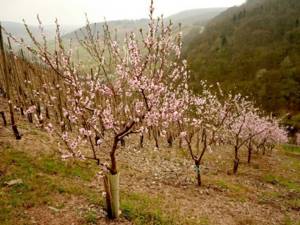
Flowering dwarf trees
To bleach or not to bleach the trunks of low-growing trees? Each gardener looks at this problem in his own way.
Some are inclined to think that whitewashing is not worth it, while others, on the contrary, believe that whitewashing prevents the development of many diseases and is used as a preventive measure.
And it is necessary to whitewash the trunks of dwarf crops. And not for the reason that it creates a beautiful picture, but because it helps trees withstand the spring rays of the sun, temperature changes and prevents many diseases.
The trunks of both seedlings and adult plants need to be whitened. When preparing a solution for whitening seedlings, the concentration should be reduced. After all, a saturated lime solution will damage the young bark.
What is the best time to whitewash dwarf trees?
You need to whiten three times a year. The main whitewashing takes place in October, the second one is carried out in March, and the third in July.
Expert opinion
Yulia Yurievna
I have a large garden and vegetable garden, several greenhouses. I love modern methods of cultivating plants and mulching the soil, and I share my experience.
Ask a Question
Low growth trees and shrubs for landscape design
Low-growing trees or shrubs are often used to decorate the yard. This helps fill any space in the yard harmoniously. Coniferous trees and shrubs will create an excellent recreation area. They will go perfectly with ponds and waterfalls.
Each of these trees can grow alone or in a group. They can be used to plant a section of the yard around the perimeter to create a hedge. By their nature, almost all coniferous trees have a dense composition, so they will look great as a hedge.
Photo:
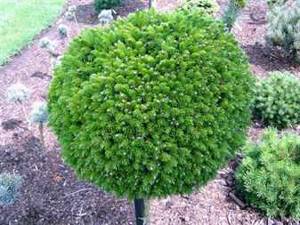
For vertical gardening, it is best to use low-growing trees that grow slowly. This will help to correct them during growth and give them the desired shape. If you plant trees correctly, your yard will have aesthetic beauty at any time of the year.
You will be interested in: Biological water treatment at the dacha: methods and types, pros and cons
Maple, ash and acacia
For single plantings, plants such as Japanese maple, weeping ash or silky acacia are often used. These trees can be placed along the alley in small groups or individually.
Japanese quince
Every gardener dreams of installing a hedge in his yard. To do this, you can use a variety of types of plants and trees. The best option is considered to be a hedge made from Japanese quince. This plant will perfectly serve as a hedge, decorate the yard and highlight the landscape design.
Small-leaved plants can be safely used for hedges. About three types of plants per meter are needed. This marking is used for single-row planting. If you need to add several rows, then it is better to increase the number of plants. As the number of rows increases, more plants also need to be used.
Photo example:
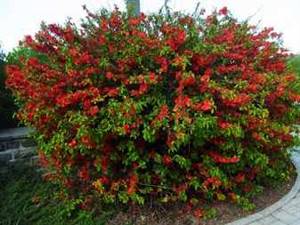
Comments (14)
Igor
12/25/2016 at 00:16 |
Trees on dwarf rootstocks quickly begin to bear fruit, but their crown is small and the number of fruits on it is also small. In addition, resistance to frost is also lower. Therefore, you don’t need to get too carried away with such fruit trees and completely plant your garden with them.Answer
Yulia Expert Plodogorod
05/05/2020 at 17:50 |
Hello, Igor! You are right, dwarf trees require specific care. Although such plants require almost no pruning, the number of fruits must be normalized. Even if a lot of ovaries have formed, you will have to remove some of them in order to reduce the volume of the harvest. If these measures are not taken, the branches may break or the culture will be depleted, which will reduce its immunity and resistance to disease.
As for frost resistance, this largely depends on the specific variety. At the same time, it is much easier to wrap a dwarf plant than a vigorous tree. Therefore, sometimes these plants suffer even less from frosty winters, provided they are properly covered. If the crown needs to be protected depending on the climate in the region, then it is better to wrap the root collar with agrofibre in any case.
To increase winter hardiness, potassium fertilizers in the autumn and winter watering are also required. It is important to remember that any weather disasters are better tolerated by strong specimens that are not affected by diseases and pests.
Considering some of the shortcomings of the plants described in the article, we recommend combining plantings on the site, using trees of different growth rates. Additionally, you need to take into account the growing conditions and the resistance of a particular variety.
Answer
Nata
01/10/2017 at 00:03 |
It is very convenient to plant such trees in the garden now. They also give birth very well, but they take up much less space than ordinary ones. You just need to choose them correctly.
Answer
Yulia Expert Plodogorod
05/07/2020 at 20:52 |
Hello, Nata! This is true, it is important not only to create the correct conditions for planting a seedling, but also to choose the right plant so that it is developed and healthy. Therefore, we recommend communicating only with trusted nurseries that have good reviews and have been located in one place for a long time.
It is also important to purchase the tree from a zoned growing center. It is better that the crop is already adapted to a specific climate, otherwise the establishment process may be delayed and the plant will develop slowly, and immunity may decrease.
When choosing a seedling, we recommend giving preference to specimens with a closed root system. Such dwarf trees take root more easily, they can be planted almost regardless of the season, and transportation is easier. If a crop is sold with bare roots, they need to be carefully inspected.
The roots should not have spots, growths, dry or softened areas. The same applies to the above-ground part. The scrap should be light in color. If the shoots are brown inside, this may indicate destructive processes in the tissues.
When transporting seedlings with exposed roots, it is better to wrap them in a damp cloth. There is no point in delaying planting such a dwarf tree. Spring time is more suitable for these specimens.
Answer
Berkutova Maya Romanovna
05/02/2018 at 14:21 |
We also plant dwarf trees, since there is very little space in the dacha, and this is a way out. We plant dwarf apple trees, pear trees (Lada variety) and felt cherry trees. Everything is growing beautifully!
Answer
Yulia Expert Plodogorod
05/28/2020 at 11:40 |
Hello, Maya Romanovna! The small and dwarf trees you described are really convenient to grow, especially if the plot is not large. Of the listed plants, in conditions of limited space, the felt cherry requires the most specific care.
After all, if you do not pay attention to the formation of a culture, it can turn into a rather sprawling bush. If it grows too much, large-scale thinning can be traumatic for such a crop. In addition, felt cherry is often planted to create a hedge, because this plant can not only decorate the site and produce a harvest, but also help delimit zones in the garden.
Proper pruning is necessary not only to correct the shape of the crown, but also to increase the lifespan of the crop. After all, like many small trees, felt cherry usually bears fruit normally for about 8-10 years. But, with proper care and anti-aging pruning, you can extend the life of the plant to 15-18 years.
For such cherries, light and nutritious soil with a neutral reaction is needed. If the soil is acidic, we recommend regularly applying deoxidizing agents. It is better to alternate them, because if you use one thing, for example, ash, the soil may become clogged, which will impair air access to the roots. It is better to plant such a crop only in sunny and warm areas.
Answer
Irina
05/11/2018 at 01:59 |
And I grow them in my garden) It seems to me that they look very elegant and beautiful on the site. Dwarf apple trees give me an excellent harvest every year - the apples are tasty, juicy and have a long shelf life.
Answer
Yulia Expert Plodogorod
05/28/2020 at 12:14 pm |
Hello Irina! To ensure that your dwarf apple tree does not become depleted and continues to produce high and tasty yields, it is necessary to properly fertilize the crop. It is important to remember not to use too much nitrogen-containing products. Small, especially early varieties require low doses of nitrogen. In addition, an excess of this element leads to an increase in vegetative mass to the detriment of fruiting.
It is important to remember that for trees on dwarf rootstocks, the application depth should be no more than 20-25 cm, otherwise the surface root system can be damaged. It is better not to disturb newly planted crops at all by digging up the trunk circle and use foliar feeding and watering with nutrients.
If all the necessary substances are added during planting, then the apple tree should be fertilized no earlier than after 2-3 years. In the spring, urea, rotted humus and nitroammophoska are added. Before flowering, you can add products with boron and phosphorus. We recommend using a solution of dry boric acid and superphosphates.
Later you can add potassium to your diet. It will improve the quality of the fruits and make them sweeter. It is better to use sulfate rather than potassium chloride. The second element is more suitable for autumn application.
Answer
Natalia
10/02/2018 at 08:51 |
I planted several dwarf apple and cherry trees, but I can say that they adapt to growth and are much less accepted than ordinary ones. Out of 3-4 seedlings, at best one will remain. Perhaps I planted it in the wrong place and that’s why it happened this way. But the trees bear fruit quite well. They do not require any special care, everything is the same as with ordinary trees.
Answer
Yulia Expert Plodogorod
03.10.2018 at 15:54 |
Hello, Natalia. When planting dwarf trees, it is important to position them correctly. There is a misconception that if they are small they don't need space, but this is not true. Therefore, out of 4 seedlings, one, the strongest, survives. Plants should not compete for light and nutrients. Minimum distance: 4.3 meters between rows and 2.1 meters between trees. Optimal placement: 4.5 meters between planting lines and 2.7 meters from tree to tree. Work out a plan before purchasing planting material.
Additionally, if so many apple and cherry trees are dying in your garden, it may be due to wind damage to the root system. In these plants it is weaker than in ordinary ones. Therefore, be sure to install special supports and secure them carefully. Alternatively, if there are a lot of seedlings, you can make stretchers, like for grapes, only from denser ropes or twigs.
If trees die immediately after planting, the reason may be diseases or pests. For example, slugs or chafer larvae may simply eat them. Therefore, when preparing the place, make sure that there are no suspicious lumps. If necessary, remove them manually or spread poison.
In early spring, it is worth spraying your seedlings with insecticides and fungicides; this will get rid of both harmful insects and fungal diseases. This is done before the buds begin to form, otherwise there will be a chemical burn.
Answer
2symmy
05/26/2019 at 00:30 |
For my six acres, and for the entire dacha community, dwarf trees have become an ideal option. At almost every dacha we have dwarf trees planted and growing well.
Answer
Yulia Expert Plodogorod
05/31/2019 at 21:26 |
Hello! You are absolutely right, such plants have quite a lot of advantages, not only the ability to be used in a small dacha. These are productive trees that bear fruit quite early and are not too difficult or burdensome to care for. But, along with this, there are also some peculiarities of care. By following them you can get a good harvest and a healthy garden.
These trees are more demanding on the composition and structure of the soil than their medium-sized and vigorous-growing comrades. It should be loose so that there is no stagnation of moisture. But at the same time nutritious. For this reason, you should pay more attention to watering and fertilizing. But we do not recommend loosening the soil; you can damage the root system, which is close to the surface.
The rest of the care mainly comes down to pruning, covering for the winter, constructing supports and preventing the appearance of pests and diseases. If you decide to start one or more of these plants, we recommend adding complex mineral and organic fertilizers to the planting hole. This will improve the development of the seedling. When planting, do not sprinkle the grafting area with soil.
Answer
Alina
04/25/2020 at 00:23 |
It turns out that there are so many nuances when growing dwarf trees. I had never considered planting dwarf plants, I didn’t even think about it. It's great that they save space.
Answer
Yulia Expert Plodogorod
05/28/2020 at 12:28 pm |
Hello, Alina! You are absolutely right; when planting such crops, there are a number of features that differ from planting vigorous plants. For example, you should not make the planting hole very deep in order to pour a nutritious soil mixture into which mineral fertilizers have previously been added into the lower layers.
Some elements will simply lose their properties while the roots of the dwarf tree grow to the lower level, and those that will still be effective may remain inaccessible due to their depth. Due to the characteristics of the root system, these plants are suitable for areas with close groundwater.
However, if the upper layers of the soil are swampy and contain a large amount of peat, then the trees described will not take root. There are also some peculiarities in care. So loosening should be very careful and superficial, or it is better to do with mulching. It is better to cover adults, as well as recently planted specimens, before the onset of winter cold.
Even in warm regions, it is better to protect the trunk circle with an additional layer of mulch or agrofibre. Old sawdust or deoxidized peat are also suitable for covering the soil. Organic matter, hay and other similar materials can attract pests and contribute to the development of infection under the tree.
Answer
What are we talking about?
The fact is that if the size of the plot is small, the selection of trees must be treated extremely carefully. Do not expect that naturally tall, stocky representatives of the fauna will grow slowly or, at the sight of the owner with a lopper in his hands, will meekly form picturesque crowns of the required volume. Most often, hopes are not justified, and overgrown specimens have to be parted with.
A strict height limitation will help you avoid disappointment - no more than 5-6 m, and these are dwarf varieties.
Choose them from reliable, trusted nurseries. One of the practical options: weeping forms grafted onto a standard - a successful combination of an expressive, spectacular crown and small stature. The tent-shaped crown grows extremely slowly in height, while its diameter can be quite impressive.
If there is room for a wide weeping crown, choose cultivars whose branches fall almost vertically to the ground parallel to the trunk. Of course, such trees will not cover a group of vacationers with their blessed canopy and will not protect them from prying eyes.
However, on a small plot of land, pergolas, arches and canopies successfully cope with these tasks, and decorative dwarf forms acquire independent value as a durable landscape decoration with all the signs of an adult tree in miniature.
Weeping forms are propagated by grafting onto a standard, so the size of the tree is determined by the height to which the graft is made. You can purchase either a completely miniature tree, which in the composition will replace a tall herbaceous perennial, or a taller tree, under the crown of which you can even hide from the sun.
True, it is not worth setting up a permanent area for receiving guests under a green tent, since soil compaction will not benefit more demanding decorative forms. A crown in the form of an umbrella or tent is inherent in a number of garden cultivars by nature, but corrective pruning will still be needed to maintain the characteristic silhouette.
Mainly, poorly located branches and shoots that grow in an undesirable direction are removed. For some tree species, candelabra-shaped pruning is used.
The general rule for all grafted plants is to prevent the appearance of shoots from the rootstock. If buds appear on the trunk below the grafting site, remove them immediately. In garden design, weeping standard trees attract attention from afar.
Therefore, they can serve as an independent decoration, for example, when planted alone on a lawn or near a pond, or as a central element when creating landscape compositions in combination with herbaceous perennials and low shrubs. Tip: plants will take root better in the garden and overwinter safely if they are planted in the spring. Regular watering is required during the year of planting.
Features of planting dwarf conifers
Despite their relative unpretentiousness, dwarf trees need to carefully choose a place for planting. Areas that are protected from drafts but still sunny enough are well suited for this purpose. A lack of natural light will cause the needles on the lower branches to fall off, and the plant will lose its decorative value.
In addition, dwarf forms are very sensitive to sunburn and lack of moisture. Therefore, in the spring they must be shaded, and they are also watered regularly, while avoiding waterlogging of the soil. It is better to plant such crops together with a clod of earth so that the crop takes root faster in a new place. After planting, the branches need to be regularly inspected and periodically sprayed, since such plants are more likely than others to be susceptible to fungal diseases.
Features of "dwarfs"
Dwarf fruit trees for the garden are a group of crops characterized by their small height and the presence of an end point of growth. All compact fruit trees are divided into two groups:
- natural “dwarfs”, growing up to 1.5-2 meters and stopping on their own;
- grafted “dwarfs”, which can be obtained by grafting low-growing varieties of fruit trees onto a special dwarf rootstock. Such trees, as a rule, grow up to 2.5-3 meters; they must be pruned correctly, limiting growth and regulating the direction of shoots.
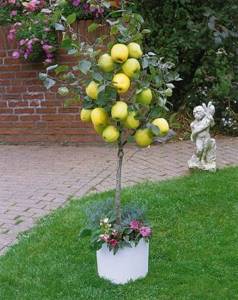
When choosing dwarf varieties for growing on your own plot, the gardener should know about some of the characteristics of these trees. First of all, “dwarfs” have a small crown and an equally compact root system. Therefore, they require much less space in the garden than regular tall varieties.
With all these advantages, it is necessary to understand that the root system of dwarf fruits is located superficially, so the tree will need more moisture and nutrients.
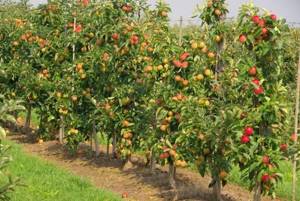
Another feature of dwarf fruits is earlier fruiting - already in the second or third year after planting, the gardener can expect the first harvest. Natural “dwarfs” have a short life cycle - about 10-15 years; after this time, the trees age, and their productivity sharply decreases. Grafted low-growing varieties live longer - 20-30 years, here a lot depends on the life expectancy of the rootstock.
Advantages and disadvantages
Most reviews about dwarf fruit trees are positive - these crops are in demand among gardeners, more and more high-quality rootstocks are appearing, and there is a choice in accordance with the climatic characteristics of the region.
The biggest advantage of low-growing varieties is the ease of growing and caring for them: it is much easier to maintain a two- to three-meter tree than a taller crop.
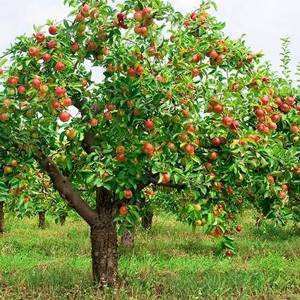
The advantages of dwarf breeds do not end there; gardeners note the following qualities:
- Early fruiting. Already two to three years after planting, a low-growing seedling begins to bear fruit, and within 6-8 years the tree’s fruiting becomes stable. This occurs several years earlier than in conventional tall varieties.
- The yield of “dwarfs” is no worse, often even better, than that of ordinary fruit trees. It is thanks to this quality that dwarf crops have become so widespread: in a small area, you can collect as much fruit from a small tree as from a tall one.
- The quality and size of the fruits of the “dwarfs” are in no way inferior to standard varieties of fruit trees. The fruits are just as tasty, juicy and aromatic. And their size is often even larger and more uniform.
- The compact size of the crown greatly simplifies tree care. Trimming, spraying, and harvesting becomes much easier; high ladders and special devices are not needed.
- A dwarf tree will require much less nutrients and processing agents, which is a significant saving on the gardener’s budget.
- The ripening time of fruits in dwarf varieties is shorter and earlier than in ordinary trees. This is due to accelerated vegetation and rapid sap flow.
- Compact dimensions allow you to grow one tall tree or 4-6 “dwarfs” in the same area.
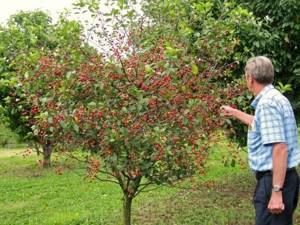
This is not to say that the disadvantages of a dwarf garden are very critical, and it is better to abandon the idea of compact gardening. But these nuances must be taken into account:
- Large material investments. You will have to spend a lot more money on purchasing seedlings than on purchasing conventional varieties. The problem is solved by grafting inexpensive low-growing varieties onto a dwarf rootstock. But, even in this case, you will have to spend money on purchasing a couple of plants instead of one.
- Frequency of care. You need to care for a dwarf garden in the same way as a traditional one. But this will have to be done more often: mini-trees should be watered regularly, fertilized more, and treated consistently against pests and diseases.
- On average, “dwarfs” live half as long, so the gardener will have to uproot old plants more often and buy new ones.
- Low trees with a shallow root system have a harder time standing up under gusts of wind or the weight of the crop, so they need supports.
- Due to their high yield and poorly developed root system, dwarf trees need to be fed more abundantly and more often. For this purpose, both organic and mineral fertilizers are used.
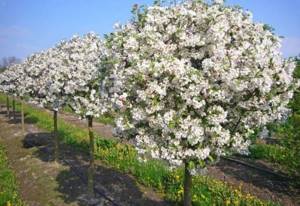
Dwarf crops definitely deserve attention. It is better to check the quality of such varieties through your own gardening experience.
Coniferous compositions in landscape design
Flower beds and decorative perennials have long been used by gardeners in landscaping city yards and suburban areas. Abroad, gardens and vegetable gardens have long been abandoned in favor of neat beds of decorative herbs and compact vegetable crops. In the East, for many centuries the Japanese have been practicing a “rock garden” with sakura, red maple, wild grapes and low-growing conifers. The culture of gardening courtyards and thoughtful landscape design is actively taking root in our country.
Central Russia is the natural environment of many species of pine, larch, cedar and juniper. A little further south, Mediterranean cypresses, thujas and other heat-loving evergreen tree-like conifers are perfectly cultivated. Surprisingly, apart from blue spruce and some other pyramidal forms of this conifer, no other related plants were used. The exception was the resorts of Crimea and the North Caucasus, where even in Soviet times, parks and alleys were decorated with rare species of evergreen forms.
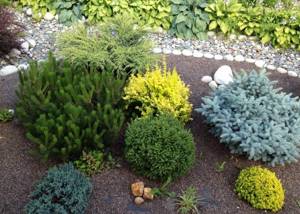
Today, decorative forms of coniferous plants are increasingly used in landscape design and gardening of household plots. Asian and Mediterranean forms, through the efforts of domestic and Dutch breeders, are adapted to our climatic conditions. Although evergreen, heat-loving plants are increasingly decorating our plots, many conifers native to Italy, Korea and Japan need to be sprinkled with sawdust on the roots and wrap the crowns for the winter.
Dwarf conifers
Above we looked at fruit-bearing trees, but there are also dwarf spruces for the garden that will help you make your site as attractive as possible from a decorative point of view.
There are many varieties of coniferous dwarf trees, which are distributed into several groups, depending on the shape of the plant.
Let's consider the main ones:
- Globular:
- western thuja - this tree does not exceed thirty centimeters in height, has a beautiful dark greenish tint of needles;
- spruce - grows up to half a meter in height, but has a dense crown with light green needles;
- mountain pine - grows from twenty to fifty centimeters, has dark needles.
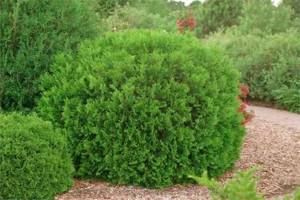
In the photo - western thuja
- Conical:
- mountain pine - this type of plant can reach up to two meters in height, and its needles are dark green, surprisingly thick and incredibly beautiful;
- gray spruce - grows up to sixty centimeters, the needles have a slightly bluish tint;
- Serbian spruce grows only twenty-five centimeters, and the needles are dark green.
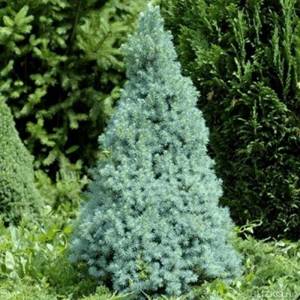
- Columnar:
- the eastern thuja grows a maximum of sixty centimeters, and the color of the needles is slightly yellow;
- Virginia juniper - can reach three meters in height, the crown is quite narrow, and the needles give off a slight blue color;
- berry yew - the height of individual specimens can be either eighty centimeters or two meters. The needles have a slight yellowish tint.
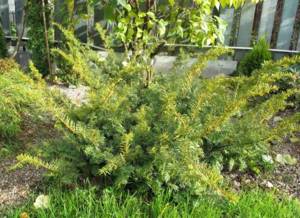
Berry tist - evergreen shrub
- Creeping:
- horizontal juniper - the height does not exceed twenty centimeters, and the color of the needles is slightly silver, with a slight blue tint;
- prostrate juniper also does not grow higher than twenty centimeters, the needles are green on one side and bluish on the other.
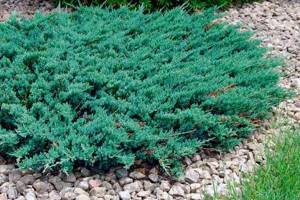
In the photo - horizontal juniper
Note. Using different varieties of dwarf coniferous trees and plants, you can create an amazing composition. It will become a true decoration of the garden, and the corner in which such plants grow will undoubtedly be your favorite.
Coniferous and evergreen trees
Coniferous and evergreen plants complement deciduous trees, giving the site a decorative appearance even in winter. They also differ in final sizes, as well as growth rates and crown shape:
Nootka cypress Pendula.
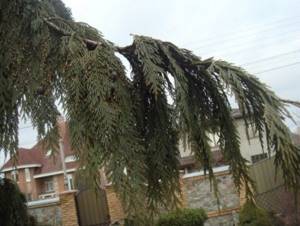
Weeping form with shoots tending to the ground. The plant gives high annual growth, by 10 years it reaches a height of 3 meters and lives for centuries.
The needles are dark green, the crown is pyramidal, with a hanging crown, good frost resistance.
Thuja Smaragd.
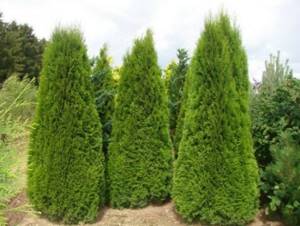
One of the most popular varieties in Russia, capable of rapid growth. An unpretentious plant with a pyramidal crown, up to 3 meters high. It tolerates haircuts well, is resistant to frost and does not become exposed in the lower part.
It retains the green color of the needles well and does not turn yellow with normal watering.
